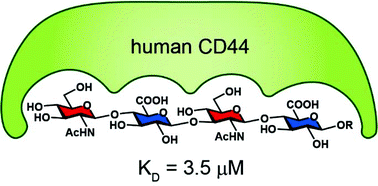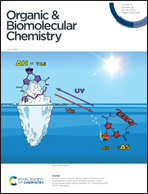Synthesis of hyaluronic acid oligosaccharides with a GlcNAc–GlcA repeating pattern and their binding affinity with CD44†
Abstract
Hyaluronic acid (HA) is a ubiquitous glycosaminoglycan in the extracellular matrix and a ligand of CD44, a transmembrane glycoprotein that is important in cell migration. Crystal and NMR studies found a hexasaccharide of the pattern (GlcA–GlcNAc)3 as the shortest HA that could bind to CD44, but molecular dynamics simulations indicated that a tetrasaccharide of the pattern (GlcNAc–GlcA)2 is the key structure interacting with CD44. Access to oligomers with such a repeat pattern is crucial in binding studies with CD44. Here we developed a synthetic procedure to afford the HA oligosaccharides with the GlcNAc–GlcA repeating unit and measured the binding interaction between these sugars and human CD44 by isothermal titration calorimetry (ITC). During the chemical synthesis, we successfully generated the β-glycosidic bond in the absence of neighbouring group participation and overcome the issues in the oxidation step. In addition, ammonia-free dissolving metal reduction for debenzylation and azido reduction has been applied in carbohydrate synthesis for the first time. ITC analysis revealed that the HA tetrasaccharide (GlcNAc–GlcA)2 could indeed interact and bind to the human CD44.

- This article is part of the themed collection: Glycosylation: New methodologies and applications


 Please wait while we load your content...
Please wait while we load your content...